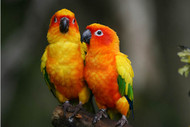Sun Conure Fact Sheet
Posted by Sun Conure Facts, Sun Conure Parrots, Sun Conure Diet, Sun Conure Behaviour, Fact Sheets on 9/1/2024
Rosemary Low tells us more about the Sun Conure.
Scientific name:
Aratinga solstitialis
Origin
Brazil only in Roraima state, in the north-east corner; central Guyana, now known only from the Karasabai and Karanambo areas where it is local and uncommon.
It is extinct throughout most of its former range.
In Birds of Northern South America, Robin Restall wrote:
“…Very rare in Venezuela, only seen near Santa Elena and sighting contested on grounds of habitat.”
Adult length:
30cm (12in)
Click here for everything you need for Sun Conures
Adult weight:
120g
Potential lifespan:
30 years

Habitat
Forest and scattered scrub in grassland with Mauritia palms.
Status in wild
It might come as a surprise to many people who view the Sun Conure as fairly common in aviculture to know that it is now a threatened species whose numbers have crashed in recent years. More about this below.
Why are they endangered?
It was only quite recently that the realisation dawned that Sun Conures had been trapped almost out of existence. During the 1980s the people of Karasabai in southern Guyana trapped large numbers; the conures would be collected by dealers from Georgetown.
On one occasion a dealer pulled a gun on villagers to avoid paying for the trapped birds. That triggered the decision to stop trapping and protect what became probably the last population of Sun Conures in Guyana, on the Ireng (or Ureng) River (which forms the border between Guyana and Brazil), about one hour north-west of Karasabai.
During the next 20 years, other populations were wiped out. It is very sad indeed to know that the demand from bird keepers has caused this near-extinction especially in a species that is easy to breed in an aviary.
Immature birds
The plumage is variable but some birds have a lot of green feathers in place of the orange plumage of the adult. The under parts are mainly greenish-yellow and the upper part of the back is mainly green. The skin surrounding the eye is whiter than in adults. Full adult plumage is acquired at about two years.
General remarks
There are some birds that are so striking you can never forget your initial impression of the species. In July 1971 I saw the Sun Conure for the first time at the premises of a dealer. I was enraptured by their beauty. I wrote at the time: “No artist’s portrayal could do justice to their striking and unique colours. The fiery orange combined with golden-yellow would delight the most demanding aesthete!” Alas, how the years make one blasé! Nevertheless, this is still one of the most gorgeous aviary birds anyone could own.
Suitability as a companion
Conures acquired young can make the most adorable pets. Unfortunately, the Sun Conure has a voice so harsh and loud that many lose their homes when they become adult. Does the seller of that irresistible, dark-eyed, hand-reared baby warn you of the problem? I don’t think so.
Be warned and be sure to listen to the vocal accomplishments of an adult bird before you decide to bring one into your home unless, of course, you are deaf, then a Sun Conure could be the perfect companion.
Breeding
Sun Conures nest readily. The female lays three or four eggs which are incubated for about 24 days. Young spend seven to eight weeks in the nest. They can be bred in family groups. If the aviary is large enough, the young can be left with their parents and will help to rear the chicks in the following year. However, colony breeding, i.e. with non-family members, is not recommended.
Mutation
When I was in Australia in the late 1990s a breeder took me to his home to show me the pied mutation he had bred. He had several pieds and had not sold any. However, when he gave up birds a few years later the mutation was not established. It was exceptionally beautiful: the entire wings and back were golden-yellow.
Feeding
A Parakeet mixture plus some soaked or sprouted white sunflower or safflower can form the basis of the diet. Sun Conures need plenty of fresh fruits and vegetables on a daily basis. Green leaves, such as those of young dandelions, spinach and Swiss chard or even beetroot leaves are very nutritious. Seeding dock and spray millet make enjoyable additions to the diet. Breeding birds will rear better young if they are provided with sprouted seeds, lentils (use whole ones — split lentils cannot germinate) and mung beans.
Click here for Sun Conure food.
If you have enjoyed this article or have any thoughts, please leave your comments for others below…
Here is everything you need for Sun Conures.


